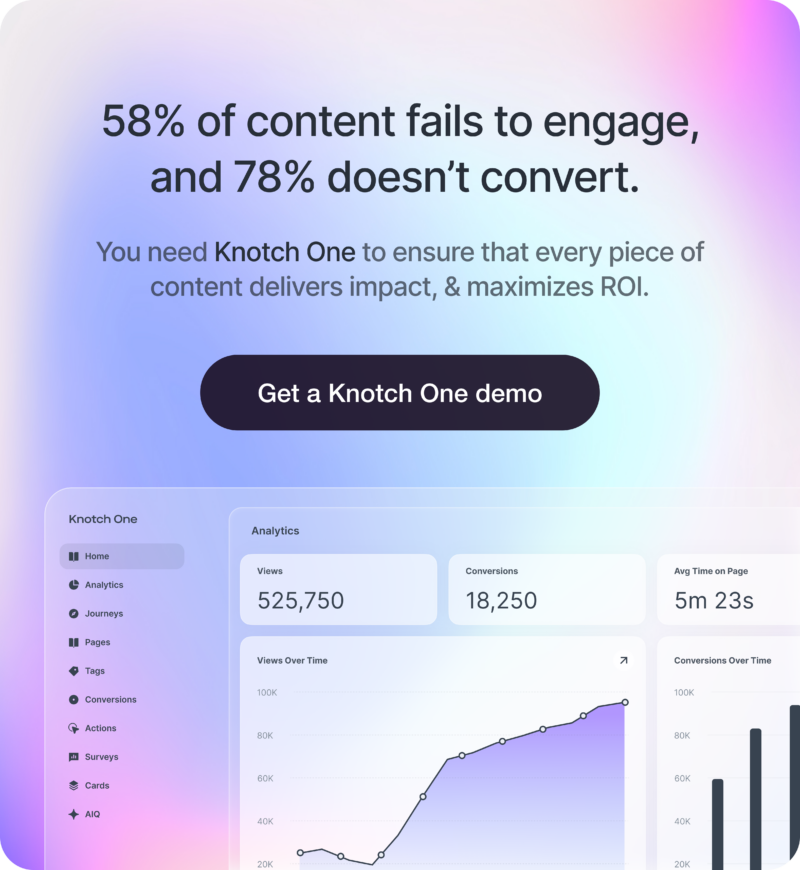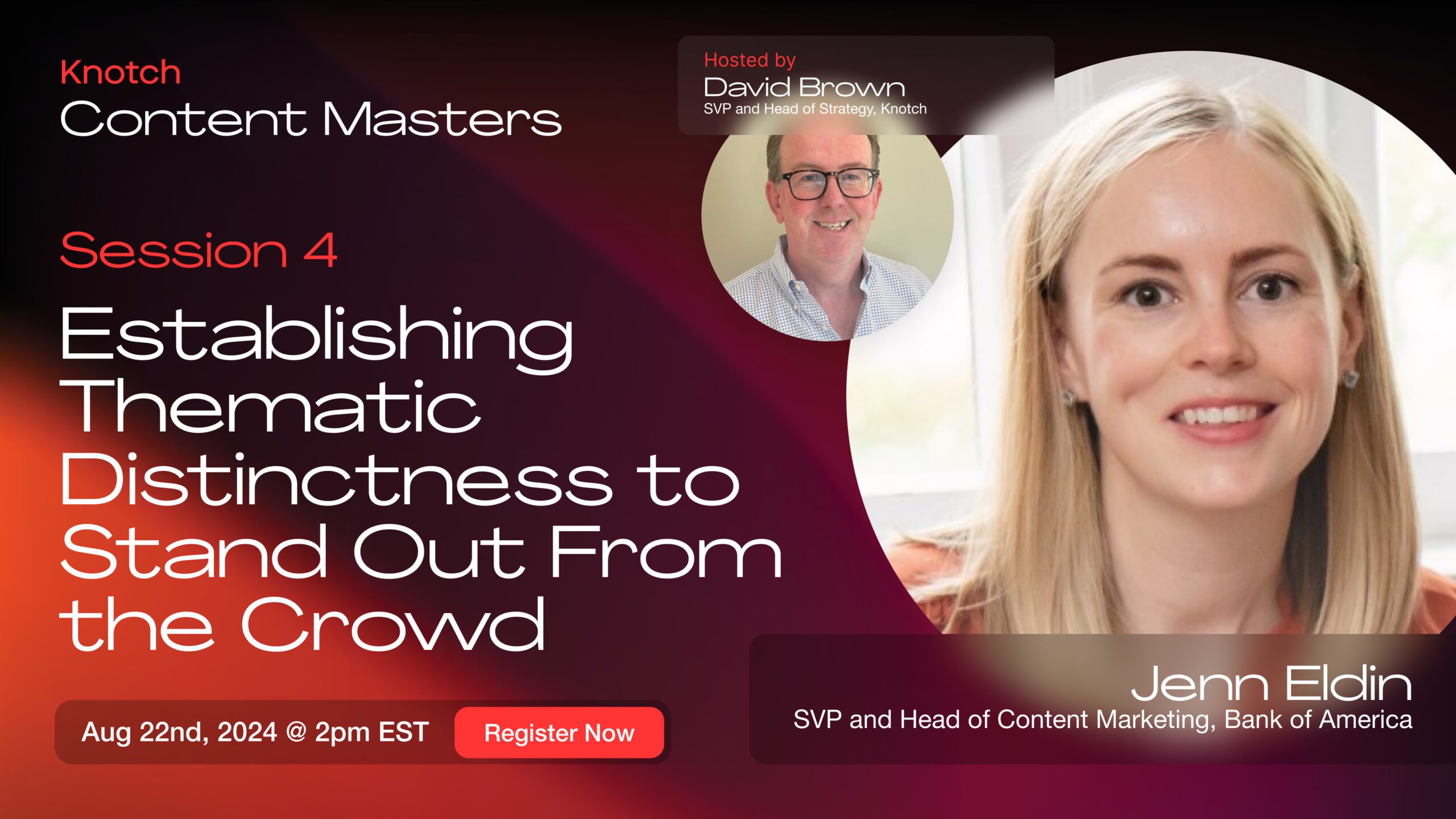Content marketing is moving from the sidelines to being front and center as strategies, plans, and tactics are developed and executed. In Knotch’s humble view, go-forward roadmaps for content need an urgent update to capture all the opportunities for growth that face marketers.
You may be thinking why Knotch would even have a perspective on marketers’ roadmap for finding content success. Well, Knotch measures and advises marketers of over 50 large enterprises around their content performance, and has a unique and objective vantage point of the reasons why your content roadmap needs an urgent update.
Reason #1: Audience > Content
“Content is king” was the war cry from Bill Gates’s famous essay of 1996. Knotch continues to believe this is a dangerous thesis, because it implies content is the end goal, rather than the business outcomes that content is designed to meet.
The audience really is king and queen. The best content teams have the most intimate understanding of their audience. Period.
Successful brands understand the importance of tailoring their content to meet the unique needs and preferences of diverse audience segments. From understanding demographic differences to leveraging psychographic insights, marketers are increasingly prioritizing audience-centric approaches — because they work.
Mallory Russell, Vice President of Global Content and Web at Square, highlighted the importance of being customer-centric, and the superpower that content teams have to understand what the consumer wants even before they do. Anticipating customer needs, and creating content to support them, creates deep connections with the customer, which ultimately will turn them into brand advocates.
Rather than content is king, content is currency that meets, understands, empathizes with, and helps solve for audience needs at each stage of the journey.
Implications: Content teams and audience teams need to work closely, or even consider coming together formally.
Reason #2: Personalization > One-size-fits-all
The majority of content does not perform well because it is not relevant to its audience. Knotch’s overall analysis of over 50 marketing teams – across industries such as banking, real estate, travel, auto and tech – found that a staggering 30% of content negatively impacts brand sentiment. An additional 28% has no discernible impact on audiences.
In a nutshell, most content, at best, is just a brand’s equivalent of background noise.
Audience preferences are constantly evolving, and, as mentioned, content must dynamically adapt to meet their needs at every stage of the customer journey. However, the dual emergence of personalization engines that are built into the website CMS and Generative AI which allows content to be rapidly versioned to different audiences and situations makes personalization become an achievable goal.
Knotch has seen that the benefits are immediate as engagement and conversion rates will multiply by 2x – 5x, and retention rates and lifetime value will grow.
Implication: Create strong stakeholder partnerships as the personalization journey is a joint venture, including technology, legal, security, and brand.
Reason #3: Content quality > content quantity
Content teams once raced to create large volumes of content to meet the voracious needs of Google and various channels and touchpoints. It’s now becoming clear that the winners in organic search are the companies with the highest quality, accurate content that has human oversight.
Quality will not be a subjective matter defined by the department head, but will be defined from the content’s ability to achieve the objectives that it is working against.
If it meets and achieves these objectives, it is higher quality than content that does not meet the objectives.
Amanda Curtin, Vice President of Content and Social Media at Synchrony, emphasized that more is not always better when it comes to content marketing. And with the right data, marketers are able to make the case for creating content that drives results, versus just creating content for content’s sake.
Content taxonomy should move from being a technical requirement to a strategic advantage, as the tagging of content allows quality of content and strategic performance to become easier to wrap your arms around. It’s easier to understand the performance of 100 tags than thousands of content assets.
Implication: The use of measurement systems focused on content will become more prevalent and a daily routine for content teams to use for decision making support.
Reason #4: Automation > development
The emergence of CRM systems with the ability to create triggered programs across multiple channels connected to audience behavior is now being combined with the Gen AI capability to create high quality, relevant content – truly a formidable duo.
Workflows, quality control, and governance need to be carefully defined and implemented. This is often not the favorite territory for content leaders.
Implication: Explore the addition of a program management platform or team to manage the added complexity.
Reason #5: Magic middle > Missing middle
Marketers have long found it difficult to understand what is driving journeys in the middle. The first touch and the last touch attribution is simple, but what drives consideration and intent is harder to pinpoint.
As measurement platforms strengthen, it will be possible to see what touchpoints and content have a disproportionate effect on business outcomes. The missing middle becomes magical, and teams can focus on building consideration, knowing that it will result in increased revenue.
As Franklin Parrish, Kaiser Permanente’s Mid Atlantic head of brand, marketing and creative services shared: “This key stage in the customer journey is where savvy marketers can build brand loyalty, improve the consumer experience, and drive conversions. Grasping the middle funnel’s intricacies is crucial for brands aiming to stand out in a competitive market.”
The move to the magic middle will also have an organizational effect. Content team’s responsibility will move from audience building (think organic search and blog) to a broader audience journey and user experience perspective.
Content experience and user experience are becoming one and the same, and who better to map out how important elements like interactive content (quizzes, poll, charts and infographics, virtual and augmented reality, and gamification can be introduced into user experience to improve business outcomes.
Implication: UX and content teams to work closely together, or even merge for teams that are focused on owned channels alone.
Reason #6: YouTube > Google Search
YouTube search offers unique advantages for marketers compared to Google search, primarily due to its focus on video content, which is highly engaging and holds viewers’ attention longer.
Users often turn to YouTube for how-to videos, tutorials, and reviews, putting them in a discovery mindset that makes them more receptive to marketing messages.
YouTube’s algorithm excels at recommending related content, increasing the chances of organic discovery. Additionally, while Google search is crowded with SEO-optimized content, YouTube still provides opportunities to rank high with the right video keywords and tags. The platform also allows for direct audience interaction through comments, likes, and subscriptions, fostering community and providing instant feedback.
Knotch has seen several marketers lose significant organic search traffic as Google makes organic life harder and harder, and then regain their organic audience with YouTube.
Implication: Develop operational plans to scale video efforts, either internally, externally or with customers.
Reason #7 Intelligence > Reporting
The Achilles heel of the content marketing arena has always been its lack of ambition to truly deliver business outcomes; pigeon-holed as an audience or brand builder, but not trusted with more meaty objectives like retention, lifetime value, and even conversion.
However, that is now changing as content marketing matures and stakeholders see results that are moving businesses forward.
The presence of a detailed measurement framework that aligns the business outcomes, objectives, and KPIs that content efforts address will be a requirement. And investments in content intelligence that go beyond web analytics will deliver eye catching insights and ROI details. Over time, investments will be made into higher performing strategies, and activities that are under-performing will be fixed or retired.
As Ian Port revealed, sometimes marketers must be ruthless about scrapping things that the data tells them no longer work.
Implication: Build budgets to support content intelligence tools, and foster expert talent to manage the adoption of insights into strategies and tactics.
So, there are the 7 reasons that marketers should consider as they update their roadmap for 2025 and beyond.
Please let the Knotch team know if you would like a second opinion on your roadmap and priorities to meet your 2025 objectives. We would be happy to help.







